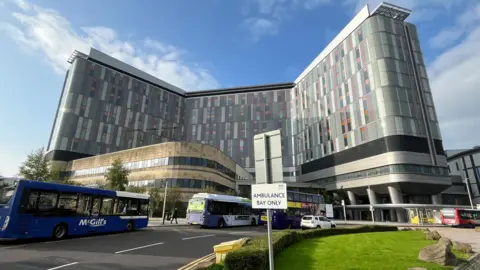No direct evidence of hospital infection link, says medical chief
 BBC
BBCA senior medical director has told an inquiry there is no direct evidence that unusual infections in child cancer patients were linked to a Glasgow hospital building.
Professor Alastair Leanord, the chief of medicine for diagnostics at NHS Greater Glasgow and Clyde, was the lead infection control doctor in 2019.
He said there was no evidence that bacteria in the water supply infected patients at the Queen Elizabeth University Hospital campus in Glasgow, which includes the Royal Hospital for Children.
Prof Leanord told the Scottish Hospitals Inquiry an assumption had been made that the same organisms were in the hospital environment and the patients, but added: "That is not what the evidence says.”
The public inquiry is investigating patient safety issues and links to the construction of the QEUH campus.
The hospital opened in 2015, but a series of infection outbreaks and concerns around the water and ventilation systems began to emerge three years later.
Other senior infection control doctors have told the inquiry that there was a link between the hospital's water and ventilation systems and increased infections.
Prof Leanord is a microbiologist who advised the Scottish government on healthcare associated infections.
On Tuesday, he said he carried out genomic sequencing work on tens of thousands of water samples taken between 2015 and 2020 at the Glasgow hospital to see if there was evidence of direct transmission from the environment to patients. He found none.
Prof Leanord acknowledged that his research did not rule out a link, but said it could not be proven.
“I wouldn’t say there was nothing going on... all I’m saying is the data shows there is no evidence of direct transmission between the environment and the patient," he said.
Increased use of antibiotic
Prof Leanord told the inquiry that he was not a water or ventilation expert.
He said he believed that an increase in the use of a particular antibiotic was one of the main reasons for higher numbers of unusual infections in child cancer patients at the hospital.
He said there was evidence that some potentially deadly bacteria that originate in water, such as Stenotrophomonas, could be resistant to certain antibiotics.
He said that even if prescribed drugs many months previously, the bacteria could remain in the gut for up to a year.
A Stenotrophomonas infection was a contributory factor in the death of 10-year-old Milly Main, who was treated for cancer at the hospital in 2017.
Prof Leanord told the inquiry that the increased use of Meropenem, a broad spectrum antibiotic, in late 2017 and early 2018 may have resulted in higher than normal infections.
He said it had been used because of a worldwide shortage of antibiotics at the time.
Wards closed after infections
In 2018 the child cancer wards at the hospital were closed due to a series of infection outbreaks.
Patients were moved to ward 6A in the adult hospital so that an £8.9m upgrade could be carried out on the child cancer ward's water and ventilation system.
However, a series of infections were also recorded in patients on ward 6A and those wards were also closed for a short time.
Prof Leanord cleared these wards to reopen from a microbiological point of view in November 2019.
He said he believed there were "multifactorial" reasons for the rise in infections, including the hospital building, vulnerable patients and the way they were cared for.
“We may never know what the source is or source was - sometimes you just do not know. I cannot give you a definitive answer and if I could we may not be sitting here,” he said.
The inquiry continues.
